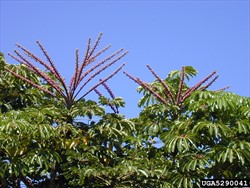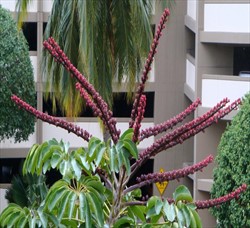Umbrella tree. It is also known as Queensland umbrella tree or octopus tree. The common names refers either to its large umbrella-like leaves or its octopus-like flowers.
Pacific Pests, Pathogens, Weeds & Pesticides - Online edition
Pacific Pests, Pathogens, Weeds & Pesticides
Umbrella tree (546)
Heptapleurum actinophyllum. Previously, it was known as Schefflera acinoplylla and Brassaia actinophylla. It is a member of the Araliaceae.
Asia, North (Hawaii, Florida) and South America, the Caribbean, Europe, Oceania. It is recorded from Australia, American Samoa, Cook Islands, Federated States of Micronesia (eradicated, 2022), Fiji, Guam, Marshall Islands, Nauru, New Caledonia, Papua New Guinea, Samoa, Solomon Islands, and Tonga. The plant is native to tropical rainforests of Australia, New Guinea, and Java.
The umbrella tree is a fast-growing, very invasive tropical and subtropical plant, often escaping from gardens where it has been planted as an ornamental. It is an environmental weed, capable of forming dense thickets taking space, light and nutrients from native species (Photos 1&2). It invades secondary (disturbed) and native forests, wastelands, and riverbanks of wetlands, and coastal sand dunes.
A number of characteristics assist its weediness: it tolerates a wide variety of well-drained soils, from clays through to loams and sands, slightly alkaline to acidic; grows in partial shade to full sunlight; produces enormous numbers of seeds that are easily dispersed and have high germination rates; and is found from the lowlands to 1000 masl.
A multi-stemmed tree, growing up to 15 m (Photo 3), occasionally as an epiphyte, growing like a strangler fig putting roots to the soil. Bark is smooth and grey. Foliage is confined to the upper parts of the tree (Photo 3). The compound leaves on leaf stalks 60 cm long, alternate along the stems, each with shiny green leaflets, up to 30 cm (mostly 10-20 cm), radiating like spokes of a wheel from a single point, drooping, giving the look of an umbrella (Photos 4&5). Flowers are in small clusters on short stalks along 60 cm spikes, above the leaves (Photos 5&6). Each flower has (usually 12) red petals, 3-5 mm long. Fruits are dark red or dark purple, round, fleshy, up to 7 mm diameter, and contain a single brown, oval seed, 4 mm by 10 mm (Photo 7).
Spread is by seeds which are produced in very high numbers and distributed by birds and bats (possibly rats). The seeds germinate on the soil surface. Dried fruits and seeds float in water and have high levels of dormancy.
The umbrella tree is reported to be invasive in some parts of subtropical Queensland, Australia, Florida and Hawaii, USA, and in tropical French Polynesia. In Australia, it is reported to damage water pipes, footpaths, and foundations of houses in places where it has naturalised; in Florida, it outcompetes threatened local species. There is also evidence of causing dermatitis in sensitive individuals.
It is used as an ornamental tree in gardens because of its hardiness but also because it attracts birds. It is used especially as a plant for the interior of houses because of it shade tolerance. Other uses are for screens, windbreaks, hedges, street plantings, and patios. Used extensively in south Florida along freeways and other roads. The fruits are eaten by kangaroos, pademelons, birds, and bats (possibly rats).
BIOSECURITY
The risk of introduction of Heptapleurum acinophyllum is high. It is demand as an ornamental tree and for landscaping (it also attracts birds and insects), and it is available to the public via the Internet. There are few countries that regulate its introduction or cultivation. In Florida, it is listed as a Category 1 invasive plant by the Florida Exotic Pest Plant Council, and the State has local laws prohibiting planting the tree.
BIOCONTROL
Not a method recommended for Heptapleurum actinophyllum
CULTURAL CONTROL
Physical & Mechanical:
- Hand-pulling (or uprooting by other means) is possible for young, isolated plants or small plantings. However, stems might break leaving roots in the ground.
- ensure all stem fragments and roots are removed from within or from on top of the soil and burn them, otherwise they may regrow.
- Do not use topsoil from places where umbrella trees have been growing. It may contain stem and root pieces which will regrow.
CHEMICAL CONTROL
In Queensland, Australia, there are no herbicides specifically registered for the management of umbrella tree, but people generally are allowed to use the following for the control of umbrella tree as an environmental weed in various non-agricultural situations under a permit (11463) issued to the Department of Agriculture & Fisheries: i) triclopyr + picloram (basal bark spray); ii) glyphosate (cut stump/paint) iii) metsulfuron-methyl (cut, frill or drill). Pickloram + aminopyralid (cut stump/paint) is also recommended (New South Wales). Methods are:
- Cut stump/paint:
- Cut trunks or stem just above ground level and paint immediately with undiluted herbicide. Monitor and repeat if required.
- Basal bark spray:
- Best for stems of 15 cm diameter or less at breast height, using systemic herbicides carried in oil (or water-soluble herbicides labeled for basal bark application) to penetrate the thin bark at the stem base.
- Clear the stem base of weeds/debris before painting or spraying the stem base (bottom 30-40 cm) with a single coat of herbicide, avoiding run-off. If spraying, start 30 cm above soil level and spray downwards, repeating this top-down spraying over all parts of the stem base. Monitor and repeat if required.
- Cut, frill or drill
- For larger trees, more than 15 cm diameter, use a drill, chisel or small axe to make a hole, cut or frill in the bark about 40 cm above ground level and at a 45-degree angle (more parallel to the bark if using a drill). Immediately after, pour in neat herbicide; repeat drilling/cutting around the tree, at slightly different levels and a few cm apart - DO NOT ringbark the tree.
In Pohnpei, Federated States of Micronesia, undiluted triclopyr used as a cut stump/paint treatment is recommended or the basal bark spray, depending on the size of the stumps.
--------------------
Note, EU approval to use glyphosate ended in December 2022, but has been extended by one year to 15 December 2023.
____________________
When using a pesticide, always wear protective clothing and follow the instructions on the product label, such as dosage, timing of application, and pre-harvest interval. Recommendations will vary with the crop and system of cultivation. Expert advice on the most appropriate herbicides to use should always be sought from local agricultural authorities.
AUTHOR Konrad Englberger & Grahame Jackson
Information from CABI (2012) Schefflera actinophylla (umbrella tree). Crop Protection Compendium. (https://www.cabidigitallibrary.org/doi/10.1079/cabicompendium.48920); Schefflera actinophylla (2023) Australian Native Plants Society (Australia). (https://anpsa.org.au/plant_profiles/schefflera-actinophylla/); and Umbrella tree Scheffleera actinophylla (2020) The State of Queensland, Department of Agriculture and Fisheries. Queensland Government. (https://www.daf.qld.gov.au/__data/assets/pdf_file/0019/51706/umbrella-tree.pdf); and Brisbane City Council (Undated) Umbrella tree (Schefflera actinophylla). (https://weeds.brisbane.qld.gov.au/weeds/umbrella-tree); and from Schefflera actinophylla (Endl.) Harms, Araliaceae (2012). Pacific Island Ecosystems at Risk (PIER). (http://www.hear.org/pier/species/schefflera_actinophylla.htm). Photos 1,2,4 &5 Forest and Kim Starr, Starr Environmental, Bugwood.org. Photo 7 Steve Hurst, USDA NRCS PLANTS Database, Bugwood.org
Produced with support from the Australian Centre for International Agricultural Research under project HORT/2016/185: Responding to emerging pest and disease threats to horticulture in the Pacific islands, implemented by the University of Queensland and the Secretariat of the Pacific.










